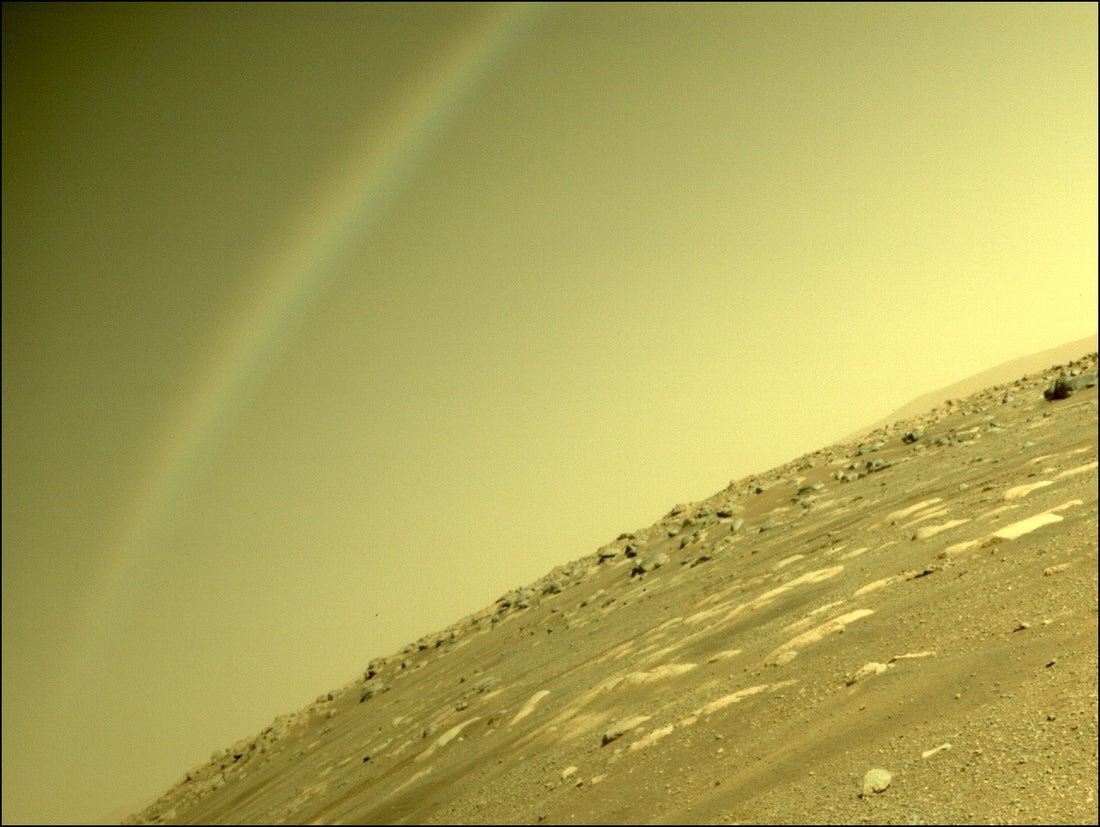
No Doofus, This Isn't A "Mars Rainbow" Caught By Persy Rover
Share
Persy Rover accidentally caught a glimpse of something from its ear Left Hazard Avoidance Camera earlier this month. And the crazies are going, well, crazy over it after Persy shared them to its official Twitter account. While it looks like a rainbow sans yellow brick road, it’s something much more simple.
And less magical.
Mars doesn’t harbour enough water droplets in its atmosphere to facilitate a rainbow. On Earth, rainbows are created from reflected light travelling through round water droplets. This makes a spectacular array as light is divided into prominent colours visible to the human eye. But on Mars, and without enough water droplets in its atmosphere, it simply isn’t possible. In fact, rain - which is the precursor to a good rainbow - is something almost entirely unique to Earth.
NASA Mars Program Office Chief Scientist Rich Zurek said during a 2015 interview that icebows might appear on Mars since although there are no water droplets on Mars, snow has been observed at the poles. But NASA holds firm that this is not the case given the position of the anomaly on Mars.
Could it be a “dustbow” as many amateur space enthusiast on Reddit attested?
Dustbows are the same as a rainbow, however, they replace the droplets in the atmosphere for (you guessed it,) dust.
So, What Is It?

NASA replied to the conjecture with a poignant and succinct answer from Perseverance’s official Twitter account:
Many have asked: Is that a rainbow on Mars? No. Rainbows aren't possible here. Rainbows are created by light reflected off of round water droplets, but there isn't enough water here to condense, and it’s too cold for liquid water in the atmosphere. This arc is a lens flare. pic.twitter.com/mIoSSuilJW
— NASA's Perseverance Mars Rover (@NASAPersevere) April 6, 2021
"Many have asked: Is that a rainbow on Mars? No. Rainbows aren't possible here. Rainbows are created by light reflected off of round water droplets, but there isn't enough water here to condense, and it's too cold for liquid water in the atmosphere. This arc is a lens flare," via @NASAPersevere.
A lens flare is caused by a bright light source shining into the lens, like the sun. As the camera that caught the effect is not a primary one for photography and used more for traversing the Martian terrain, it has no sun visors. Hence the thinking behind the lens flare. NASA personnel further tweeted:
"I have sunshades on my front Hazcams, which were considered mission-critical (I need them for driving forward & I'm usually driving forward). Sunshades weren't considered essential on my back Hazcams, so you can see scattered light artifacts in their images,"
This was supported by Dave Lavery, the program executive for Solar System Exploration at NASA, who told Forbes, “Definitely not a rainbow. … It is just internal reflections in the camera lens. The rover is almost due north of the helicopter, so the camera is looking almost straight south at about 2:00 p.m. local Mars solar time when these images were taken," he said, adding that those are the prime conditions for stray light to interfere with a camera’s optics.
But did that stop the tinfoil hatters from hatting? C’mon, are you new to the internet? Within minutes the comment section was full of people speculating on a dot.
A dot.

Source: https://twitter.com/i/status/1379544939235713024
And yet another simple explanation for this one.
With a lower gravitational pull on the planet - around 37.6% that of Earth - and literally everything is covered in dust…
It’s dust.
And like Forrest Gump, that’s all we have to say about that.
Love this article?
We love you for reading it.
If you’d like more ARSE in your life, jump on into our official Australian Space Society for banter, answers and more.
#Space_Aus




